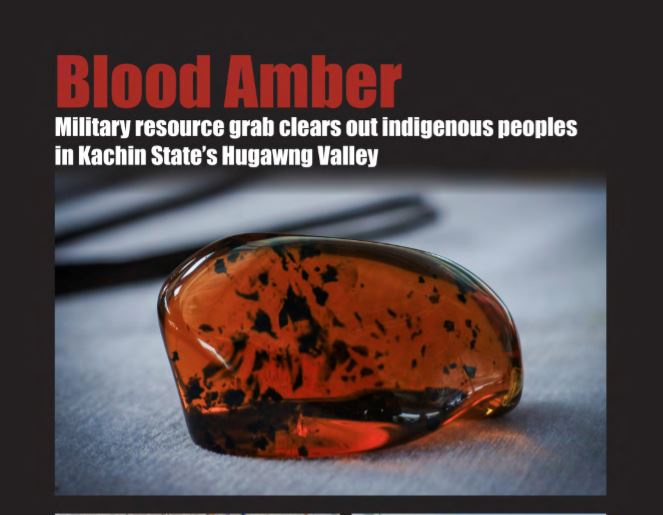Blood Amber: Military Resouce Grab Clears out Indigenous Peoples in Kachin State’s Hugawng Valley
20 August 2019

Summary
In 2018, Burmese government troops stepped up their war in Kachin State, further driving out indigenous populations and expanding control over the area’s rich natural resources and trategic trading routes. The fiercest offensive was fought in northwest Kachin State’s Hugawng Valley, to secure the historic Ledo Road linking India and China, which is part of China’s Belt and Road Initiative, and to seize hugely lucrative amber mines.
Kachin State amber is a global treasure: it is the only type in the world formed during the age of the dinosaurs. “Blood amber” is the Chinese name of the extremely rare, deep red variety of the gem found only in the Hugawng Valley – a name which resonates grimly with local residents who have been driven out by the recent offensive.
The amber mining boom began in 2010, due to demand from the Chinese market, causing tens of thousands of migrant miners from across Burma to flock to the region. In 2015, discovery of a 99-millionyear-old feathered dinosaur tail in Hugawng Valley amber further fuelled the trade.
The Kachin Independence Army (KIA) controlled the remote amber mining area, but the Burma Army collected taxes on all amber transport routes as the precious resource was exported across Kachin State into China, where the annual value of the trade is estimated at 1 billion USD a year.
In June 2017, the Burma Army moved to take over the amber trade at the source. They used aircraft to drop thousands of leaflets over the mining area, ordering all local residents to evacuate within ten days –or be branded as KIA insurgents. This included not only the mine workers but also nearly 5,000 indigenous villagers who had lived and farmed there for generations.
The offensive lasted nearly one year, during which civilians suffered not only the seizure of their lands and property, but also military harassment and violence. On January 26, 2018, three civilians were killed by an aerial attack, including the young mother of a 3 year-old child.
In January 2018, nearly 3,000 civilians were trapped in the conflict area by the Burma Army, who refused to allow them to pass to safety, holding them for eleven days without proper food or healthcare and blocking delivery of humanitarian aid. To this day, the thousands of indigenous inhabitants of the amber mining area are living in makeshift shelters in urban church compounds, unrecognized as IDPs and unable to return home.
Despite using the premise of “protecting the environment” to justify the offensive, unregulated amber mining resumed in the region just one year after the offensive began, exposing the Burma military’s real motives in seizing the mines.
The offensive follows a repeated pattern of military expansion and violence against ethnic peoples in Kachin State in order to consolidate extractive businesses to profit the military and central government at the expense of local indigenous populations.
Past documentation by KDNG has already shown that, far from protecting the environment, the government and military has been responsible for large-scale environmental destruction in the Hugawng Valley over the last 20 years. It has authorized destructive gold mining throughout the valley, and given permission for Yuzana Company to destroy hundreds of acres of forest and farmlands to carry out monocrop agriculture for the Chinese market. Similarly in nearby Hpakant, jade mining has expanded exponentially since government security forces seized control of the mines, generating huge profits for government and military elites, while driving local people off their lands and destroying their livelihoods.
The central government must recognize the rights of indigenous peoples to live on their land and manage their own resources, and must immediately take steps to allow people displaced from the amber region to return home.
Constitutional change is critical to resolve conflict in Burma. Local people in Kachin State must own, manage, and receive revenues from the natural resources of the land where they live and work.
International pressure is urgently needed to help protect civilians in conflict zones in Kachin State and elsewhere in Burma. Foreign economic investment and peace process funding hould be frozen until the Burma military stops its offensives against Kachin and other ethnic peoples. In the meantime, international humanitarian aid should be sent to help communities displaced from their homes and livelihoods by central government aggression.
Announcements
21 May 2025
Open letter: Malaysia must lead ASEAN with principle, not hypocrisy, to address the Myanmar crisis

Progressive Voice is a participatory rights-based policy research and advocacy organization rooted in civil society, that maintains strong networks and relationships with grassroots organizations and community-based organizations throughout Myanmar. It acts as a bridge to the international community and international policymakers by amplifying voices from the ground, and advocating for a rights-based policy narrative.